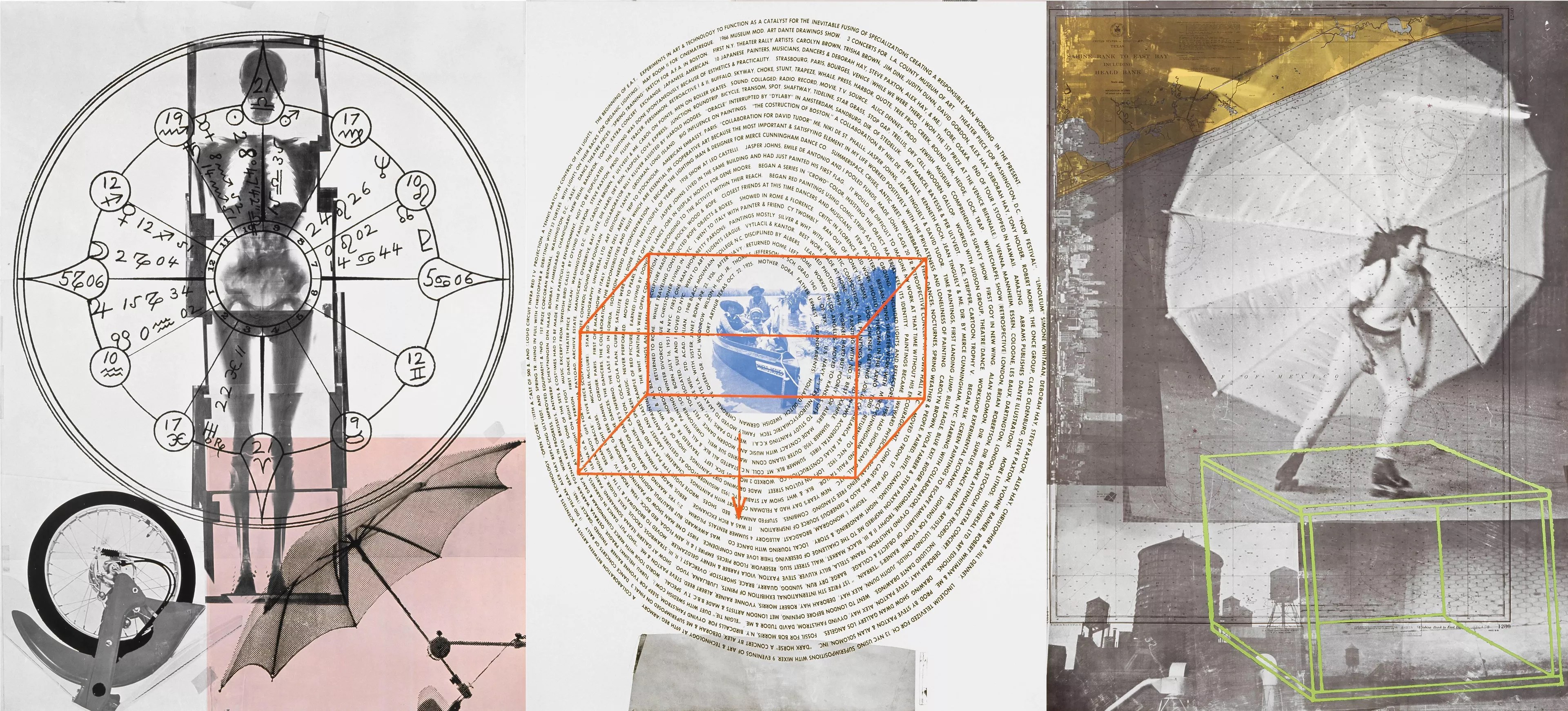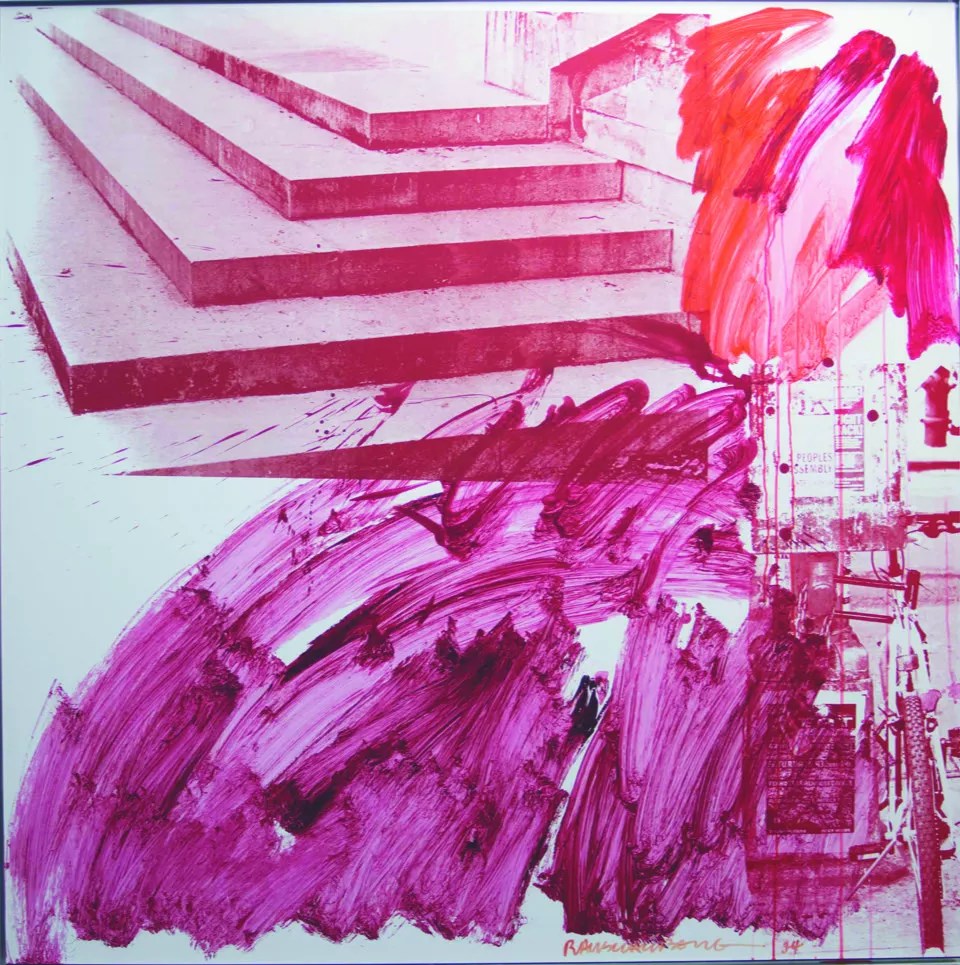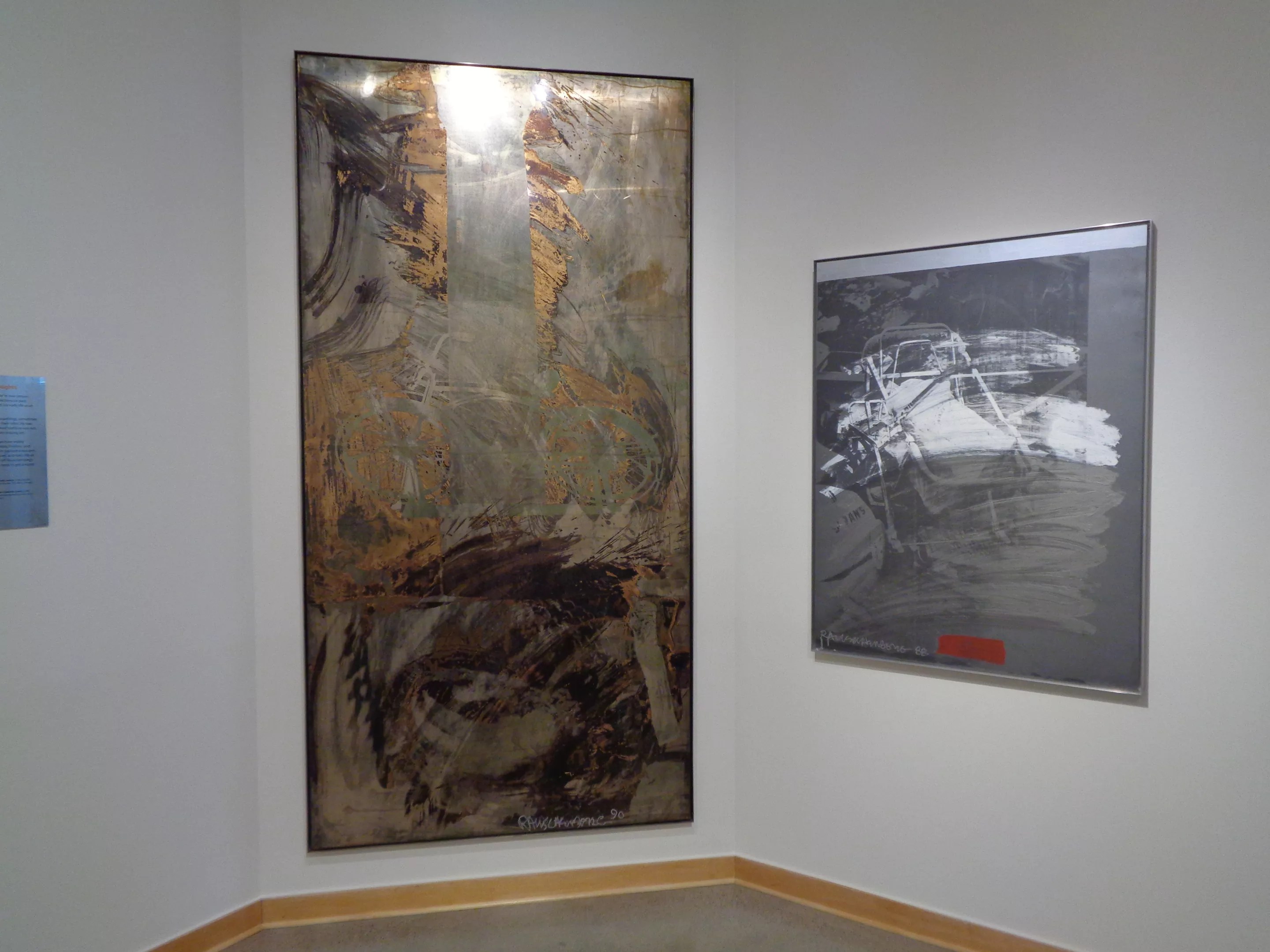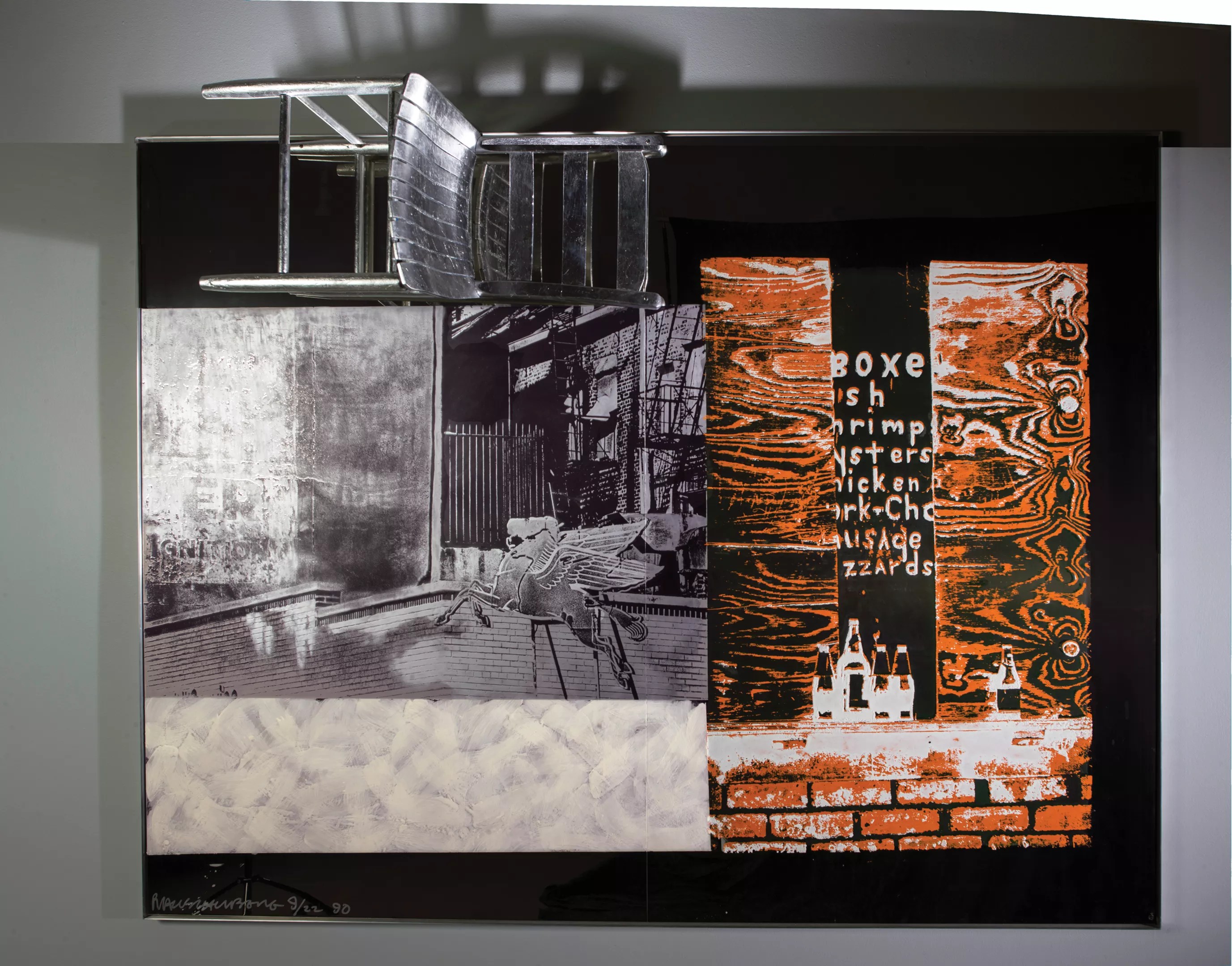
Courtesy of the Museum of Outdoor Arts

Audio By Carbonatix
Robert Rauschenberg is one of those artists who’s so famous that we use just his last name, as the Museum of Outdoor Arts does in the title of Rauschenberg: Reflections and Ruminations, which just reopened in Englewood. Shows devoted to the work of a single art giant aren’t common in metro Denver, but in this exceptional art season, not only did the Denver Art Museum build a blockbuster around Monet, another one-name-suffices artist, but now Rauschenberg is enjoying a local outing.
As with the Monet exhibit, the MOA’s Rauschenberg show has been years in the making. Decades, really: John Madden, real estate magnate and the father of Cynthia Madden Leitner, with whom he launched the MOA, got to know Rauschenberg personally in the 1970s, when he and his wife had a home on Captiva Island, Florida, where Rauschenberg was based. According to Madden Leitner, few people lived there at the time, and it was inevitable that her father and the artist would wind up meeting. Retrospectively, it also seems inevitable that they would develop a friendship based on their shared interest in art. Madden is a noted art collector who also founded the Madden Museum; the museum’s $10 million-plus collection was given to the University of Denver in 2016. The Rauschenbergs that he and his late wife collected, now in DU’s collection, are part of the MOA’s Rauschenberg show.
The Madden Rauschenbergs are not the core of the show, however, but instead used to enhance and expand on the main private collection that anchors the exhibit and sparked Madden Leitner’s idea for the show in the first place. That collection has been loaned to MOA by an anonymous collector who had a longtime personal and professional relationship with Rauschenberg. He also has an ongoing friendship with Madden Leitner, who notes that the exhibit has come together through personal relationships developed over decades.

Robert Rauschenberg’s “Big and Little Bullies,” from the “Ruminations” series.
Courtesy of the Museum of Outdoor Arts
Despite her closeness to the chief lender and to the material, Madden Leitner decided not to curate the show herself, but instead tapped a couple of independent professionals, Dan Jacobs and Sarah Magnatta. To some extent, the curators were limited by the work offered by the anonymous collector, which dates from the 1990s to Rauschenberg’s death in 2008, but they were able to find additional Rauschenbergs that take viewers back to earlier phases of the artist’s oeuvre. These earlier, and even contemporaneous, pieces were loaned not only by DU, the CU Art Museum and the MOA itself, but also by other collectors, as well as Universal Limited Art Editions, the printmaker that carried out most of Rauschenberg’s work in multiples from his earliest days as an artist.
Despite these expansions and enhancements, Jacobs and Magnatta could not present a fleshed-out chronological retrospective; what’s on view instead is an in-depth concentration on Rauschenberg’s prints, with special attention given to the newest ones. And at the very front are a series of prints that take us back to the heroic days when Rauschenberg and his circle of friends and associates changed the course of international contemporary art in the 1960s.

Robert Rauschenberg’s “Ruby Climb.”
courtesy of the Museum of Outdoor Arts
Even before you enter the museum, you encounter three enormous prints in the lobby, collectively titled “Autobiography,” all from 1968 and meant to reflect on the artist’s life. “Autobiography” was done in the cheap-to-make offset method in an enormous edition, so that almost anyone could afford to buy the prints (those days are long gone, needless to say). The first is dominated by a full-body X-ray of the artist, with photo transfers of a bicycle wheel and an open umbrella. The second has a photo transfer of Rauschenberg as a kid in a boat, surrounded by text that orbits the image in an oval. The final print includes a famous image of Rauschenberg performing in roller skates and parachute.
In these, Rauschenberg shows off his gift for compressing art history while subverting the standards of picture- making. Sometimes the image has a hieratic placement, while other images have been freely placed in the compositions, reconciling expressionism with formalism, for instance. This is why he can be seen as a bridge between the abstract expressionism of his mentors and the pop art of his crowd, as well as those influenced by him. Looking in the rear-view mirror, it’s seems clear that what Rauschenberg was actually doing in works like these prints was updating and revitalizing Dada, as he did through his entire career.

Installation view of Rauschenberg: Reflections and Ruminations .
Robert Delaney
The curators underline the context in which they cast the show – later work seen as heirs to the artist’s golden era – by following these prints with pieces from the 1999 “Ruminations” series, which also looks back at Rauschenberg’s life, returning conceptually to the days when “Autobiography” was made. In the “Ruminations” prints, which are essentially composed montages of old photos, Rauschenberg makes direct and indirect references to that crowd of cutting-edge creative friends, including onetime partner Jasper Johns, along with Cy Twombly, John Cage, Merce Cunningham and even Andy Warhol, among others. Interestingly, though Rauschenberg and Warhol were not very close, Warhol wound up having more influence on Rauschenberg than closer contacts, as the more recent pieces prove.
While the show includes all kinds of magnificent things, the pieces done on large metal panels are a revelation. Some are made of bronze that has been covered in acrylics and solvents to produce patinas, like the richly adorned “Anchored,” from the Borealis series of 1990. It looks luxurious, with silver shades set against gold ones, an impression in no way contradicted by the mundane object that’s the predominant element of the composition: a bicycle.

“Pegasits,” by Robert Rauschenberg.
Courtesy of the Museum of Outdoor Arts
Though also done in metal, the pieces made of sheets of mirror-finished stainless steel have a very different aura. A masterpiece of this type is “Pegasits,” done in 1990 and one of Rauschenberg’s favorites from that time. The imagery includes a photo transfer of the Mobil Oil symbol, the Pegasus tiled with other photo transfers of wood grain, text, bricks and industrial facilities; at the top left is an aluminum cast of an old chair. This three-dimensional element footnotes one of Rauschenberg’s chief claims to fame, the combine painting, in which sculptural elements are appended to paintings.
Rauschenberg’s classic approach is to instinctually arrange images and expressive passages, and the mirrored surfaces force viewers to interact with these pieces, since their reflections become part of the compositions, as kinetic elements. In pieces with more space between the images, the reflected viewer plays an even greater role, as in the stunning “Crowing,” from 1991’s “Urban Bourbon” series. In this work, a lineup of photographic images has been blotted out by big scribbles of bright colors, covering a pop-ish work with an abstract-expressionist one.
The primary lesson of this exhibit is that although Rauschenberg developed his signature style while still in his twenties, it never failed him over the course of the next sixty years. Among the fifty pieces in Rauschenberg: Reflections and Ruminations, there isn’t a single dud. Don’t miss this show.
Rauschenberg: Reflections and Ruminations, extended through March 20, 2021, at the Museum of Outdoor Arts, 1000 Englewood Parkway. Admission is $10 and children under six are free, but tickets are required for everyone because of social distancing. For more information, call 303-806-0444 or go to moaonline.org.